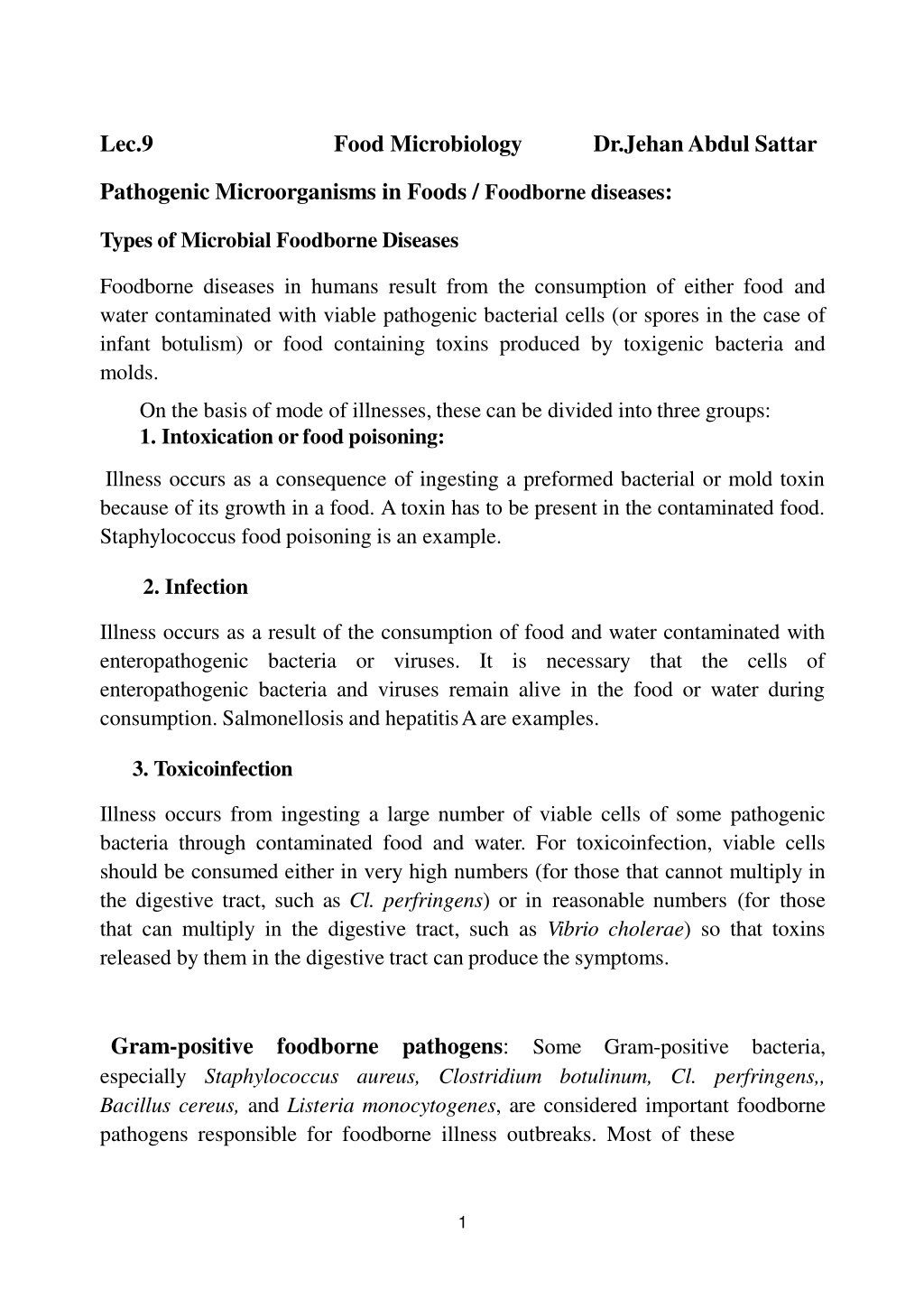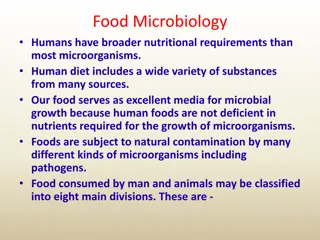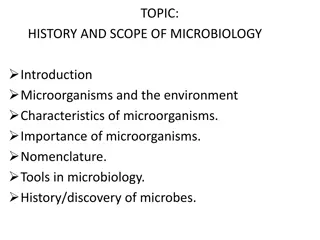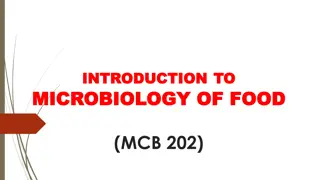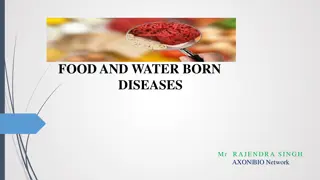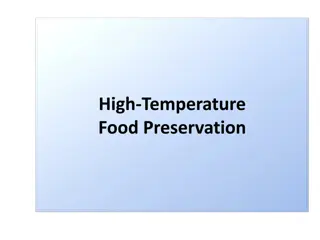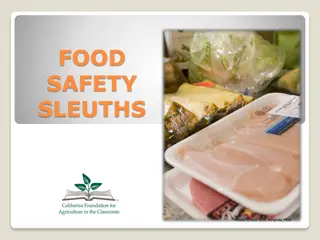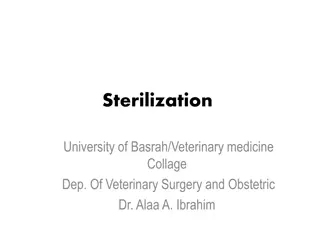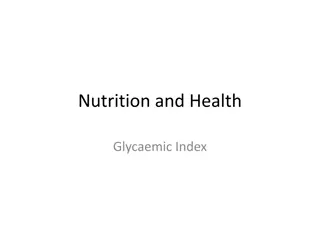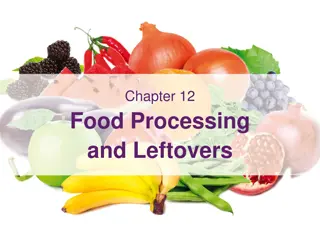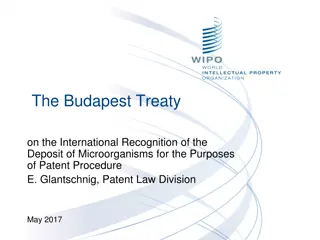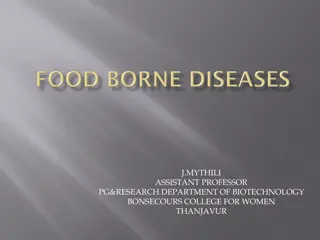Understanding Foodborne Diseases and Pathogenic Microorganisms in Foods
Foodborne diseases in humans are caused by consuming contaminated food or water containing pathogenic microorganisms or toxins. These diseases can be categorized into intoxication, infection, and toxicoinfection, each with distinct modes of illness. Pathogens like Staphylococcus aureus, Clostridium botulinum, and Listeria monocytogenes are significant culprits behind foodborne illnesses. Understanding these pathogens is crucial for preventing and managing food-related health risks.
Download Presentation

Please find below an Image/Link to download the presentation.
The content on the website is provided AS IS for your information and personal use only. It may not be sold, licensed, or shared on other websites without obtaining consent from the author. Download presentation by click this link. If you encounter any issues during the download, it is possible that the publisher has removed the file from their server.
E N D
Presentation Transcript
Lec.9 Food Microbiology Dr.JehanAbdul Sattar Pathogenic Microorganisms in Foods / Foodborne diseases: Types of Microbial Foodborne Diseases Foodborne diseases in humans result from the consumption of either food and water contaminated with viable pathogenic bacterial cells (or spores in the case of infant botulism) or food containing toxins produced by toxigenic bacteria and molds. On the basis of mode of illnesses, these can be divided into three groups: 1. Intoxication orfood poisoning: Illness occurs as a consequence of ingesting a preformed bacterial or mold toxin because of its growth in a food. A toxin has to be present in the contaminated food. Staphylococcus food poisoning is an example. 2. Infection Illness occurs as a result of the consumption of food and water contaminated with enteropathogenic bacteria or viruses. It is necessary that the cells of enteropathogenic bacteria and viruses remain alive in the food or water during consumption. Salmonellosis and hepatitisAare examples. 3. Toxicoinfection Illness occurs from ingesting a large number of viable cells of some pathogenic bacteria through contaminated food and water. For toxicoinfection, viable cells should be consumed either in very high numbers (for those that cannot multiply in the digestive tract, such as Cl. perfringens) or in reasonable numbers (for those that can multiply in the digestive tract, such as Vibrio cholerae) so that toxins released by them in the digestive tract can produce the symptoms. Gram-positive especially Staphylococcus aureus, Clostridium botulinum, Cl. perfringens,, Bacillus cereus, and Listeria monocytogenes, are considered important foodborne pathogens responsible for foodborne illness outbreaks. Most of these foodborne pathogens: Some Gram-positive bacteria, 1
microorganisms, except for L. monocytogenes and Cl. perfringens, can grow on food and produce toxins that will cause food poisoning when ingested. Among Gram-positive bacteria, Staphylococcus aureus stands out because it can grow in foods with high sodium chloride concentrations (10 20%) and low aw (0.83 0.86). Staphylococcus aureus is heat labile and produces heat-resistant enterotoxins. The disease caused by S. aureus is due to consumption of animal- origin and excessively handled foods. Staphylococcus aureus have a short incubation period and the intoxication caused is self-limiting. *The clinical symptoms associated with B. cereus poisoning are very similar to those associated with staphylococcal intoxication. However, B. cereus can cause two distinct types of foodborne illnesses, namely emetic and diarrheal syndromes. Emetic syndrome is caused by the ingestion of a preformed toxin (cereulide) in foods, which stimulates the vague nerve and causes nausea and vomiting. The diarrheic syndrome is an infection caused by ingesting bacterial cells, which then colonize the small intestine and produce enterotoxins. These two syndromes are also characterized by their rapid onset and self-limiting nature, not requiring therapeutic interventions and hospitalization. Despite this, severe and even fatal cases have been reported. *Clostridium botulinum, the causative agent of botulism, is a globally distributed bacterium. It causes a severe disease with high mortality rate due to ingestion of botulinum toxin. Botulinum toxin is performed in foods and as a neurotoxin, after absorption in the intestines, reaches the nervous system and blocks the release of acetylcholine by nerve terminals. Despite the severity of the illness, the associated neurotoxins are heat labile and can easily be destroyed by heating the food to 80 C for 20 min or 85 C for 5 min. *Clostridium perfringens is another important spore-forming bacterium widely distributed in nature and capable of producing more than 15 toxins that cause different diseases in humans and animals. Food poisoning caused by this bacterium is among the most common foodborne illnesses in the world. Food poisoning by Cl. perfringens is caused by the ingestion of at least 107cells of the microorganism, which sporulate in the intestines, releasing the Cl. perfringens enterotoxin. Differently from the above-mentioned Gram-positive bacteria, L. monocytogenes is characterized by its ability to invade intestinal cells and diffuse to other organs and tissues. It is resistant to desiccation, low water activity, and low pH and may cause anything from a mild gastroenteritis to severe infections of the central 2
nervous system and abortion, depending on the host's susceptibility. Listeriosis, the disease caused by L. monocytogenes, is a major concern for those involved in food safety because of its high mortality rates (approximately 50%). Listeria monocytogenes is a psychrotrophic pathogenic bacterium of very high importance for processed foods or minimally processed foods that are stored for medium to short periods. Gram-negative foodborne pathogens bacteria can cause foodborne illnesses, including Salmonella spp., Campylobacter spp., pathogenic Escherichia coli, Shigella spp., Y. enterocolitica, Vibrio spp., Aeromonas spp., and Cronobacter sakazakii, among others. Many Gram-negative pathogenic Among these, Campylobacter spp. has been identified as the main cause of foodborne illnesses and outbreaks in the USA and Europe. The thermophilic species Campylobacter jejuni and Campylobacter coli are the main causes of campylobacteriosis in humans. Salmonella spp. also plays an important role in foodborne illness outbreaks worldwide, being an important public health problem. Most serotypes cause gastroenteritis limited to intestinal infections, but the Typhi and Paratyphi serotypes can cause enteric fevers, which are more severe illnesses and affect other organs and tissues. E. coli are considered part of the normal intestinal microbiota of warm-blooded humans and animals, some strains can cause foodborne illnesses. These pathogenic strains can be grouped into at least six different groups: enteropathogenic E. coli (EPEC), enterotoxigenic E. coli (ETEC), enteroinvasive E. coli (EIEC), enteroaggregative E. coli (EAggEC), diffuse aggregative E. coli (DAEC), enterohemorrhagic E. coli (also known as verocytotoxin-producing E. coli, VTEC, or Shiga toxin-producing, STEC), and enteroaggregative hemorrhagic E. coli (EAHEC). Foodborne illness outbreaks have been particularly associated with VTEC and, to a smaller extent, EPEC, ETEC, and EAggEC. A great outbreak with EAHEC strain E. coli 0104:H4 occurred in Europe in 2011, with 320 bloody diarrhea cases, 850 E. coli cases of hemolytic-uremic syndrome (HUS), and 82 deaths. Yersinia enterocolitica is one of the most interesting species within the Yersinia genus, and related outbreaks are mainly associated with the consumption of contaminated pork. 3
Shigella spp. are transmitted by the fecal/oral route and ingestion of contaminated food or water. These bacteria are highly infectious and can produce the Shiga toxin, which causes the hemolytic-uremic syndrome (HUS). Vibrio cholerae, Vibrio vulnificus, and Vibrio parahaemolyticus have been associated with foodborne illnesses due to consumption of (contaminated water, vegetables, and seafood. Protozoan foodborne pathogens Protozoans are important etiological agents of human diseases that can be transmitted by contaminated water and foods. The protozoans, Giardia, Cryptosporidium, and Cyclospora are the main microorganisms responsible for diarrhea in humans. The main transmission route of these protozoans is the fecal/oral route. However, indirect transmission from pets, such as dogs and cats, and ingestion of foods contaminated with oocysts. In general, water and certain foods, such as vegetables, fruits, and seafood, which are more likely to have been in contact with diseased individuals, are the main vehicles of intestinal protozoans. Foodborne viruses Viruses are small intracellular parasites capable of causing diseases in plants, animals, and human beings. Many viruses can be found in the human intestines, but only some are generally recognized as important foodborne pathogens. Foodborne viruses attack intestinal cells and propagate within them. Later, some types of viruses may attack other cells or invade other organs, such as the liver and the central nervous system. The main genera associated with foodborne illnesses are Norovirus, Sapovirus, Enterovirus, Hepatovirus, Astrovirus, Rotavirus, and members of the Adenoviridae family, among others. Norovirus, Rotavirus, and the hepatitis A virus are the ones most related with foodborne illness outbreaks around the world. All these viruses can be transmitted through the fecal/oral route, either by direct contact with infected individuals or by ingestion of contaminated water and foods, such as vegetables, fruits, shellfish and sometimes beef. Mycotoxigenic molds Filamentous fungi can grow in foods and cause chronic disease in humans and animals because of their mycotoxins. Mycotoxins are secondary metabolites that may cause a variety of adverse effects in human beings, such as intestinal 4
symptoms, allergic responses, immunosuppression, mutagenesis, inhibition of protein synthesis and essential metabolic pathways, and cancer. Mycotoxins may be produced before harvest or during storage, and filamentous fungi need favorable water activity, atmosphere (oxygen), substrates, and temperatures to grow. The main filamentous fungal genera associated with the production of mycotoxins in foods are Aspergillus spp., Penicillium spp., and Fusarium spp. Aspergillus flavus and Aspergillus parasiticus are the main fungi responsible for the production of aflatoxin in peanuts, corn, wheat, rice, and other grains. The main types of toxins isolated from these foods are aflatoxins B1, B2, G1, and G2. They are characterized by their fluorescence under ultraviolet light. Additionally, toxic metabolites, such as aflatoxins M1 and M2, may be present in the milk of animals fed grains contaminated with type B aflatoxin. Aspergillus niger, Aspergillus ochraceus, and Penicillium verrucosum are associated with the production of ochratoxins. An important characteristic of this mycotoxin is that it is found in many different products, such as raisins, barley, soybean and coffee products, grapes, but usually in low levels. These mycotoxins can accumulate in human or animal body tissues and fluids when contaminated foods are consumed regularly. Citrinin is another mycotoxin produced by Penicillium citrinum and by some Aspergillus species. Patulin, produced by some species of Penicillium, Aspergillus, and Byssochlamys, is the main mycotoxin found in fruits, such as apple, pear, and cherry, and their derivatives. This toxin may irritate the stomach and cause vomiting and nausea. Fusarium spp. species are responsible for the production of many mycotoxins, such as fumonisins, zearalenone, and trichothecenes (deoxynivalenol, also known as vomitoxin or DON, and toxin T2); corn is the source of these mycotoxins. Mycotoxin control should be done in the entire food production chain, taking into account the interactions between toxicogenic fungi and plants, storage manner and conditions, animal contamination and metabolism, detection methods, and mycotoxin elimination from foods. 5
